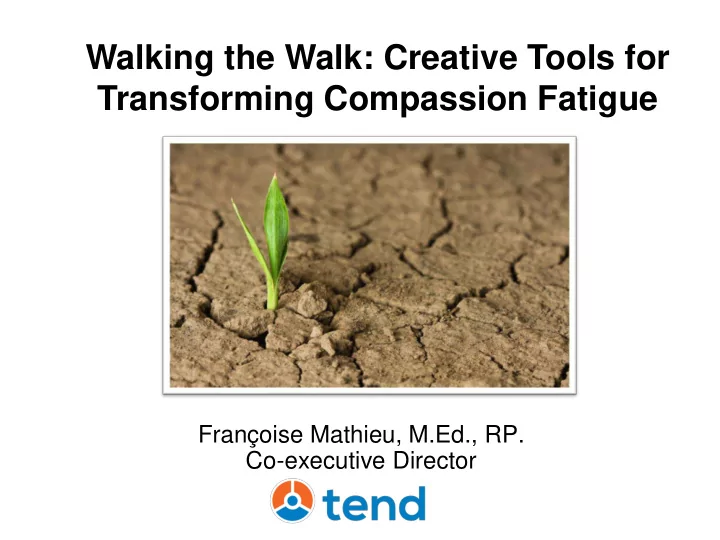

Walking the Walk: Creative Tools for Transforming Compassion Fatigue Françoise Mathieu, M.Ed., RP. Co-executive Director
Secondary Trauma
www.tendacademy.com
www.tendacademy.com
www.tendacademy.com
•Crisis intervention
Prior Training on CF/VT/STS?
Years of Experience?
What to expect from today • Low impact disclosure • Focus on what we can control • Self-Compassion • An open mind • Invitation to make one commitment to change one thing
99% of the strategies we will discuss are free
Must be nice… “ Horizontal violence ” : a direct result of Compassion fatigue and role overload
Offering ourselves compassion and forgiveness Picture of hand on heart
Self compassion break This is a moment of suffering Suffering is part of life May I be kind to myself
The high stress & trauma-exposed workplace
The complex stress model Complex Stress Model Systemic Traumatic Stress Stress Harassment & Primary Vicarious Job Stress Burnout Discrimination Trauma Trauma Dr Patricia Fisher, www.fisherandassociates.org
Awareness of the impact of psychological trauma: a fairly new concept
Primary Trauma
Ground Zero 9/11
The secondary impact on helping professionals: Vicarious Trauma/Compassion Fatigue
1995 Dr Charles Figley “ The cost of caring ”
Multiple Exposure: Increased Risk Prior Trauma Traumatic Burnout Grief/Loss Systems Direct Failure Exposure Compassion Indirect Fatigue Trauma Image courtesy of Dr Leslie Anne Ross, Children ’ s Institute Inc. Los Angeles
Moral Distress “ […] happens when there are inconsistencies between a [helper ’ s] beliefs and his or her actions in practice ” (Baylis 2000) • “ when policies or routines conflict with […] beliefs about […] patient care ” (Mitchell 2000)
Moral distress discussion • Example of a situation that creates moral distress for you • How have you dealt with this?
The Ripple Effect
The reality… •Deeply compromised system •Difficult stories •Losses •Lack of resources •Public misconception of the work that you do
The work that you do •Where do those stories go at the end of your day? •What are your vulnerabilities? •How do you protect yourself? Were you trained to do this work?
Addressing CF & VT: Key Strategies
Bober & Regehr Study, 2006
Bober & Regehr (2006) Although subjects believed that leisure and self care would reduce their STS symptoms, that was not in fact the case: Therapists did not engage in these self care practices more often when they believed in them, and when they did take better care of themselves, it did not reduce their trauma scores.
Blaming the service providers “If you had better self care, and work-life balance….” Bober & Regehr (2005)
We are an enthusiastic self- help culture…
Problem is….
We don’t always follow through…
Many Workplaces embraced Self-Care Initiatives with enthusiasm
Employees stayed away
Research started showing that reducing workload was a good place to start…
Problem is….
Trauma exposure continued…
Occupational Stressors: Direct Exposure and Prior History % witnessing CPS-Related Stressor event (N=49) Dangerous neighborhood 92 Drug abuse by client 90 Poverty and homelessness 86 Physical abuse of child 84 Educational neglect 84 Poverty and lack of food 80 Sexual abuse of child 78 Criminal activity by client 76 Poverty and lack of healthcare 69 Death of a client due to illness 47 Death of a client due to accident 33 Death of a client due to unknown cause 33 Death of a client due to murder 24 From: ACS- NYU Children’s Trauma Institute
SO, is Self Care Enough…?
So, it turns out that….
+ ≠
How do we fix this?
Your Balance Map
My Map Simplifying Physical Health Stress relief Understanding how Social/Emotional Stimulating & I react to change supports engaging work and hobbies “Trauma Managing Giving Back stewardship” occupational stress/resentment
Take stock of stressors and self care… Warning signs
The Warning Signs Continuum
My Yellow Zone…
Physical Symptoms
Behavioural Signs and Symptoms
How we transition…
Behavioural Signs and Symptoms Increased use of Anger and Avoiding clients alcohol and Irritability drugs Absenteeism Impaired ability Problems in to make personal decisions relationships Attrition Compromised Forgetfulness care for clients
Blurred Boundaries •Rescuing •Overfunctioning •Intense preoccupation with a particular case •Minimizing
Psychological signs and symptoms • Distancing • Dread of working • Negative self image with certain clients • Depression • Feeling professional • Reduced ability to feel helplessness sympathy and empathy • Depersonalization • Cynicism & resentment
Psychological signs and symptoms Con ’ t • Problems with Intimacy • Intrusive imagery • Heightened anxiety or irrational fears
Psychological signs and symptoms Con ’ t • Hypersensitivity/insensi tivity to emotionally charged stimuli • Loss of hope • Difficulty separating personal and professional lives Sources: Saakvitne, Figley, Gentry, Baranowsky & Dunning (1997).
“Grandiosity – an inflated sense of importance related to one's work” van Dernoot Lipsky (2009) Trauma Stewardship
Warning Sign?
Burnout, depression and addiction continue to be taboo topics
Stigma John Bradford
What works? Feeling effective
Are we trained to do the work that we do?
Ted Talk: Nadine Burke Harris
Adverse Childhood Experiences Study From Trauma Informed Care Stakeholders Group Training Subcommittee
“Changing the Paradigm from What Is Wrong with You To… What Happened to You?” From the www.traumainformedcare project
Self Assessment Tool The ProQol www.proqol.org
Recommend
More recommend